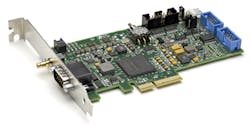In 1997, the World Wide Web was still new territory for business, bulky analog cell phones filled purses or dangled from belt holsters, and Titanic wowed audiences with its extensive use of CGI. That also was the year that BitFlow launched the Road Runner, which it called the world’s first PCI bus-mastering digital frame grabber. Powered by an early version of the company’s FlowThru architecture, combining high-speed video FIFOs with a highly optimized scatter/gather DMA, the product was an important innovation for the machine-vision industry.
Fast forward two decades and the Road Runner has been designed into thousands of machine-vision systems while machine vision as a whole has moved ahead at breakneck speed. Over the past two decades, the Road Runner has largely maintained its original design, noted Donal Waide, director of sales and marketing for BitFlow. While there remains a market for these types of boards, albeit a small one, it actually has been the company and its product portfolio that have evolved. “One of the ways we’ve done this is by using the original Road Runner as a design platform for development of newer, more advanced boards,” said Waide, first with the Road Runner CL for Camera Link applications. The evolution continued with the company’s Karbon and Cyton families that incorporate a highly developed version of the same BitFlow FlowThru architecture pioneered in the Road Runner, he explained.
“What made the Road Runner such a groundbreaking product was its flexibility,” noted Waide. “It marked a new generation of frame grabbers that could be used in virtually any imaging application requiring a digital camera or data source along with a desktop computer for processing,” he said.
Road Runner was a groundbreaking product when it came out, according to Waide, because it was the first PCI bus-mastering digital frame grabber. Today the market has migrated to PCIe. “Also, the Road Runner’s LVDS/differential interface has been first displaced by Camera Link and then by high-speed CoaXPress, GigE Vision, and USB3 Vision,” he added.
He noted that there are many basic vision applications that simply haven’t changed much over the past 20 years and that continue to be satisfied by the Road Runner’s capabilities. Technology used for these applications didn’t need to be made faster, bigger, or better, and customers have the same cameras and cables to get a job done as they did in the past, he noted. “Keep in mind that the Road Runner was ahead of its time when it came out. It took some time for machine-vision system integrators to catch up,” said Waide. Furthermore, he pointed out, there are newer customers, including students and hobbyists, who use the Road Runner as a learning and discovery tool, much like the Raspberry Pi.
“Of course,” he admits, “other customers have moved on to newer BitFlow frame grabbers”—such as the Aon-CXP low-cost single-link CoaXPress frame grabber (pictured).
The market has other players, too. For example, Keith Russell, president of Euresys, which has been in the frame grabber market since the late 1980s, said the applications for the technology have multiplied over the years. And the markets have expanded. Machine vision, for example, now includes inspection activities for large solar panels, not just small components. Improved technology has allowed machine-aided inspection to speed up dramatically, without any decrease in effectiveness. Markets also have opened in government sectors, entertainment, and autonomous vehicles.
Putting 20 years of developments like Road Runner—and many more years of machine vision—in perspective, author Winn Hardin at the Automated Imaging Association website penned an appreciation, titled “High-Speed Imaging Advances Mean Frame Grabbers Are Here to Stay.”1 Reinforcing the point of the title, Hardin cited many examples of frame grabbers both empowered by advances in hardware and in turn enabling hosts of new capabilities.
And, he noted, in the midst of all that growth, “Frame-grabber manufacturers have to support a growing number of high-speed transmission protocols while still supporting the large installed base of low-bandwidth analog cameras.” It has been quite an accomplishment so far and there’s no end in sight.
Reference
- Hardin, W., “High-Speed Imaging Advances Mean Frame Grabbers Are Here to Stay,” AIA Vision Online, Oct. 7, 2014.
About the Author


